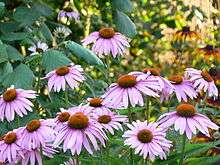Echinacea angustifolia
| Echinacea angustifolia | |
|---|---|
 | |
| Scientific classification | |
| Kingdom: | Plantae |
| Clade: | Angiosperms |
| Clade: | Eudicots |
| Clade: | Asterids |
| Order: | Asterales |
| Family: | Asteraceae |
| Genus: | Echinacea |
| Species: | E. angustifolia |
| Binomial name | |
| Echinacea angustifolia | |
| Synonyms[1] | |
|
Brauneria angustifolia (DC.) A.Heller | |
Echinacea angustifolia, the narrow-leaved purple coneflower or blacksamson echinacea,[2] is a North American plant species in sunflower family. It is widespread across much of the Great Plains of central Canada and the central United States, with additional populations in nearby regions.[3]
Echinacea angustifolia is a perennial herb up to 40 to 70 centimetres (16 to 28 in) tall with spindle-shaped taproots that are often branched. The stems and leaves are moderately to densely hairy. The plant produces flower heads one per side branch, each at the end of a long peduncle. Each head contains 8–21 pink or purple ray florets plus 200–300 purple disc florets.[2]
Echinacea angustifolia blooms late spring to mid summer. It is found growing in dry prairies and barrens with rocky to sandy-clay soils.[2] There are two subspecies:[4][5]
- Echinacea angustifolia subsp. angustifolia is native to central Canada and the central United States from Saskatchewan and Manitoba in the north to Arizona, New Mexico, Texas, and Louisiana in the south
- Echinacea angustifolia subsp. strigosa has a more limited range in Kansas, Oklahoma, Texas, and Louisiana.[6]
Many Native American groups used this plant for a variety of medicinal purposes, including pain relief and relief of colds and toothaches.[7]
References
- ↑ The Plant List, Echinacea angustifolia DC.
- 1 2 3 Flora of North America, Narrow-leaved purple coneflower, blacksamson echinacea, Echinacea angustifolia de Candolle in A. P. de Candolle and A. L. P. P. de Candolle, Prodr. 5: 554. 1836.
- ↑ Biota of North America Program 2014 county distribution map
- ↑ McGregor, Ronald Leighton 1968. Transactions of the Kansas Academy of Science 70(3): 368–369
- ↑ Tropicos, Echinacea angustifolia var. strigosa McGregor
- ↑ Echinacea angustifolia, United States Department of Agriculture PLANTS Profile
- ↑ Echinacea angustifolia. United States Department of Agriculture NRCS Plant Guide.
| Wikimedia Commons has media related to Echinacea angustifolia. |